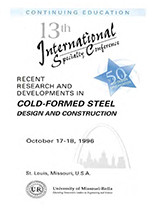Session Dates
17 Oct 1996
Abstract
A three-dimensional second-order analysis is used to study the effect of brace stiffness on the buckling strength of cold-formed steel columns. The finite element formulation uses an iterative updated Lagrangian scheme to include the second-order geometric non-linear effects in the space frame element as well as the connection element used to model a brace. Lateral brace stiffness required to achieve full bracing for a two-dimensional column, and lateral and torsional brace stiffnesses required for a three-dimensional cold-formed steel column are studied. The strength requirement for various brace components, the effects of column initial imperfections, and the impact of varying warping boundary conditions are also investigated.
Department(s)
Civil, Architectural and Environmental Engineering
Research Center/Lab(s)
Wei-Wen Yu Center for Cold-Formed Steel Structures
Meeting Name
13th International Specialty Conference on Cold-Formed Steel Structures
Publisher
University of Missouri--Rolla
Document Version
Final Version
Rights
© 1996 University of Missouri--Rolla, All rights reserved.
Document Type
Article - Conference proceedings
File Type
text
Language
English
Recommended Citation
Gupta, Pratyoosh; Blandford, George E.; and Wang, S. T., "Effect of Bracing Stiffness on Buckling Strength of Cold-formed Steel Columns" (1996). CCFSS Proceedings of International Specialty Conference on Cold-Formed Steel Structures (1971 - 2018). 1.
https://scholarsmine.mst.edu/isccss/13iccfss/13iccfss-session5/1
Effect of Bracing Stiffness on Buckling Strength of Cold-formed Steel Columns
A three-dimensional second-order analysis is used to study the effect of brace stiffness on the buckling strength of cold-formed steel columns. The finite element formulation uses an iterative updated Lagrangian scheme to include the second-order geometric non-linear effects in the space frame element as well as the connection element used to model a brace. Lateral brace stiffness required to achieve full bracing for a two-dimensional column, and lateral and torsional brace stiffnesses required for a three-dimensional cold-formed steel column are studied. The strength requirement for various brace components, the effects of column initial imperfections, and the impact of varying warping boundary conditions are also investigated.



